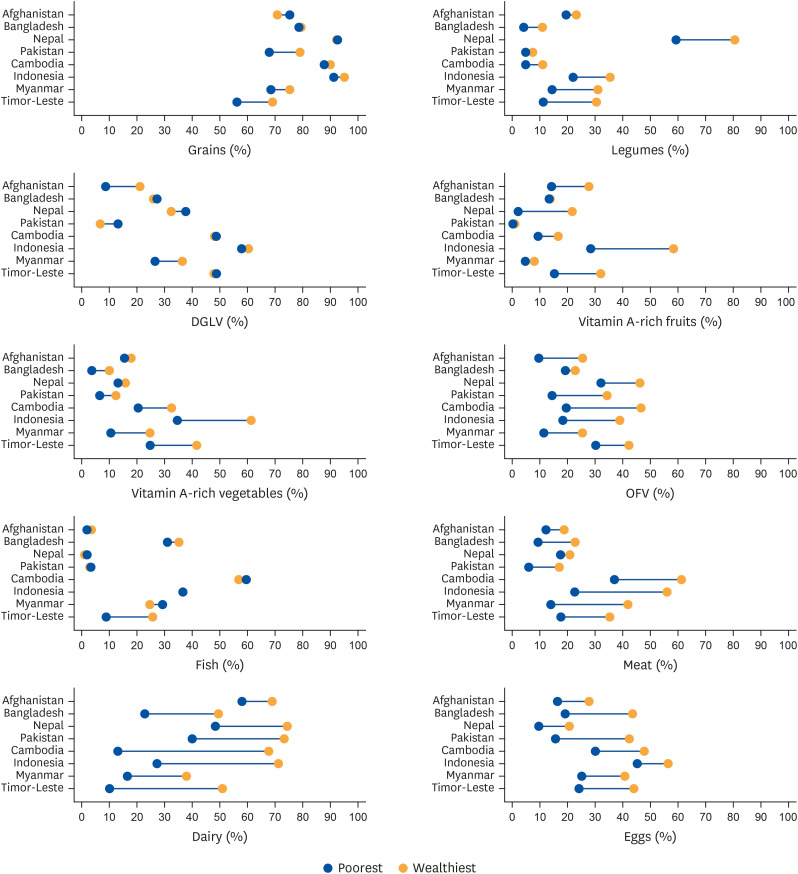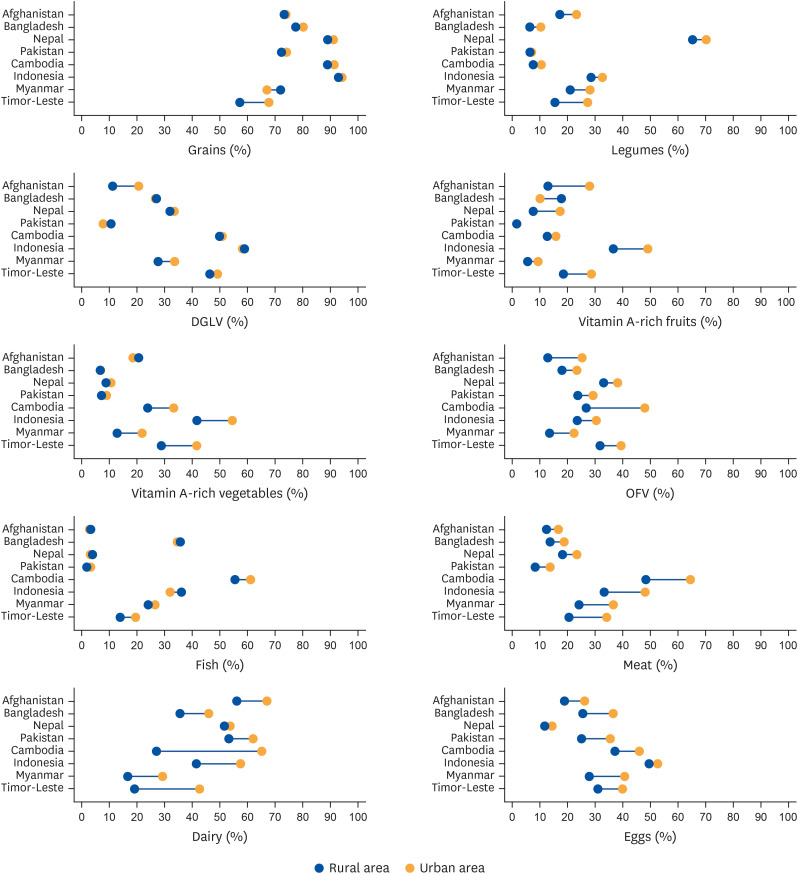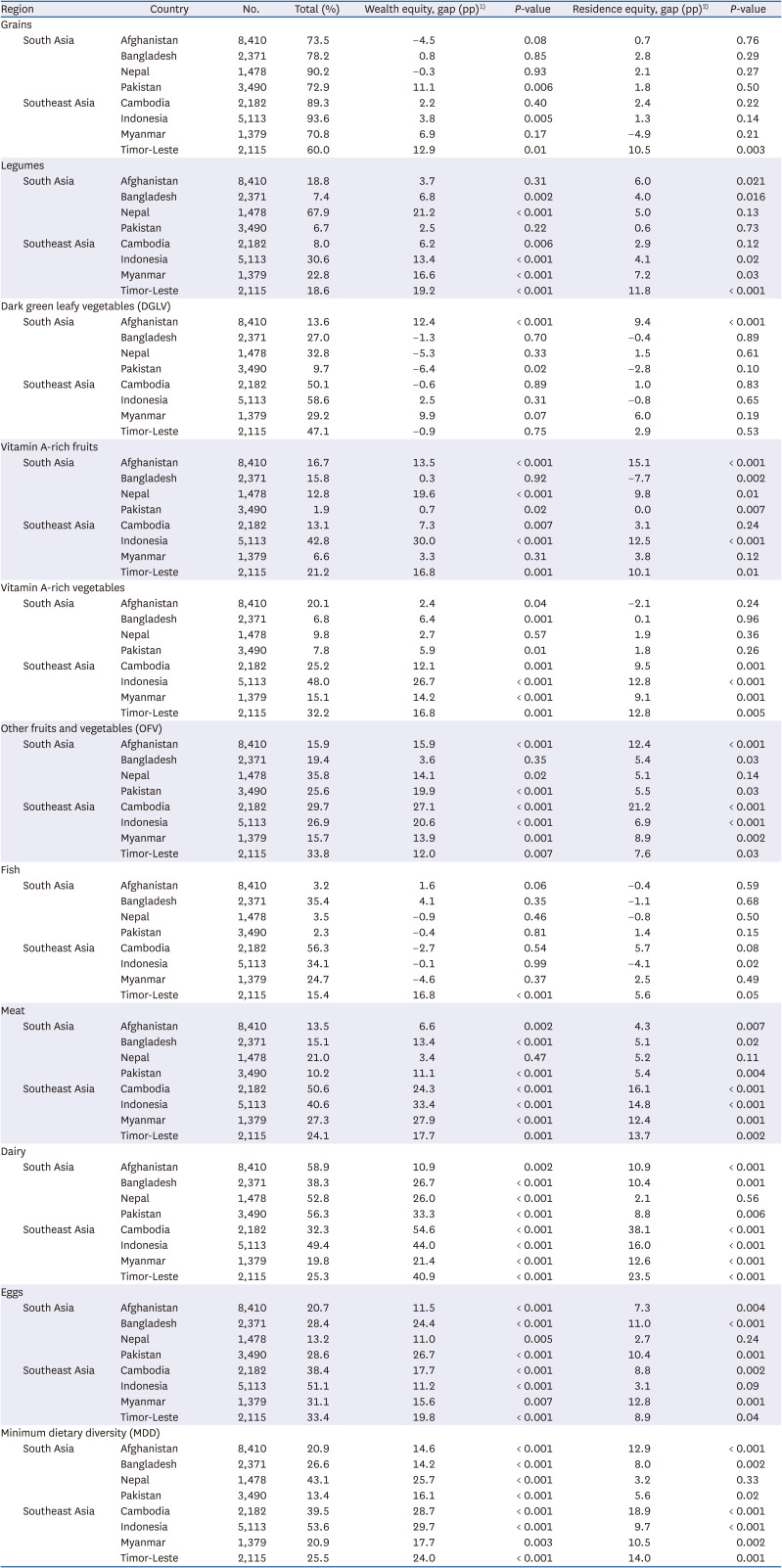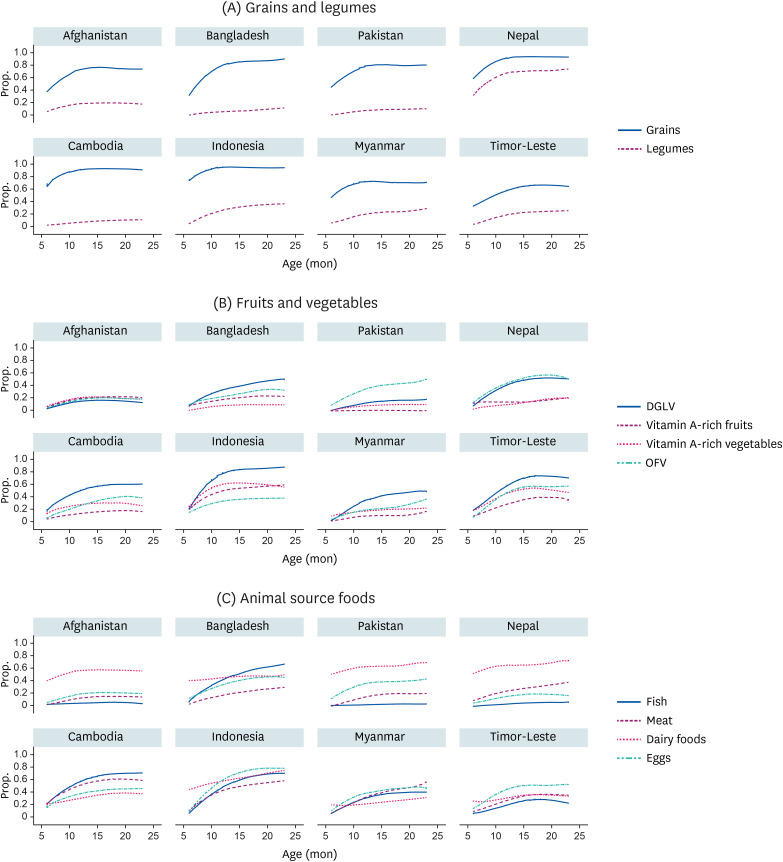1. Black RE, Victora CG, Walker SP, Bhutta ZA, Christian P, de Onis M, Ezzati M, Grantham-McGregor S, Katz J, Martorell R, et al. Maternal and child undernutrition and overweight in low-income and middle-income countries. Lancet. 2013; 382:427–451. PMID:
23746772.

4. World Health Organization. Global Nutrition Monitoring Framework: Operational Guidance for Tracking Progress in Meeting Targets for 2025. Geneva: World Health Organization;2017.
6. World Health Organization. UNICEF/WHO/The World Bank Group Joint Child Malnutrition Estimates: Levels and Trends in Child Malnutrition: Key Findings of the 2020 Edition. Geneva: World Health Organization;2020.
7. Gatica-Domínguez G, Neves PA, Barros AJ, Victora CG. Complementary feeding practices in 80 low- and middle-income countries: prevalence of and socioeconomic inequalities in dietary diversity, meal frequency, and dietary adequacy. J Nutr. 2021; 151:1956–1964. PMID:
33847352.

8. Baye K, Kennedy G. Estimates of dietary quality in infants and young children (6–23 mo): Evidence from demographic and health surveys of 49 low- and middle-income countries. Nutrition. 2020; 78:110875. PMID:
32653760.

9. National Research Council. Supplemental Nutrition Assistance Program: Examining the Evidence to Define Benefit Adequacy. Washington, D.C.: National Academies Press;2013.
10. International Center for Equity in Health. Equiplot. Pelotas: International Center for Equity in Health;2020. cited 2020 August 8. Available from:
https://www.equidade.org/equiplot.
11. Central Statistics Organization/Afghanistan, Ministry of Public Health/Afghanistan, ICF. Afghanistan Demographic and Health Survey 2015. Kabul: Central Statistics Organization;2017.
12. National Institute of Population Research. Training - NIPORT/Bangladesh, Mitra and Associates, ICF International. Bangladesh Demographic and Health Survey 2014. Dhaka: NIPORT, Mitra and Associates, and ICF International;2016.
13. Ministry of Health - MOH/Nepal. New ERA/Nepal, ICF. Nepal Demographic and Health Survey 2016. Kathmandu: MOH/Nepal, New ERA, and ICF;2017.
14. National Institute of Population Studies - NIPS/Pakistan. ICF. Pakistan Demographic and Health Survey 2017–18. Islamabad: NIPS/Pakistan and ICF;2019.
15. National Institute of Statistics/Cambodia, Directorate General for Health/Cambodia, ICF International. Cambodia Demographic and Health Survey 2014. Phnom Penh: National Institute of Statistics/Cambodia, Directorate General for Health/Cambodia, and ICF International;2015.
16. Ministry of Health, Sports - MoHS/Myanmar, ICF. Myanmar Demographic and Health Survey 2015–16. Nay Pyi Taw: MoHS and ICF;2017.
17. National Population. Family Planning Board, Statistical Indonesia, Ministry of Health - Kemenkes, ICF. Indonesia Demographic and Health Survey 2017. Jakarta: BKKBN, BPS, Kemenkes, and ICF;2018.
18. General Directorate of Statistics, Ministry of Finance/Timor Leste, ICF. Timor-Leste Demographic and Health Survey 2016. Dili: GDS and ICF;2018.
19. Mujica OJ, Victora CG. Obesity inequality among adults in Latin America and the Caribbean. Lancet Glob Health. 2019; 7:e1589–e1590. PMID:
31708129.

20. Central Statistics Organization. MoPHM, and ICF. Afghanistan Demographic and Health Survey 2015. Kabul: Central Statistics Organization;2017.
21. National Institute of Population Research and Training. Bangladesh Demographic and Health Survey 2017–18. Dhaka, Rockville (MA): NIPORT and ICF;2020.
22. National Institute of Population Studies and ICF. Pakistan Demographic and Health Survey 2017–18. Islamabad, Rockville (MA): NIPS and ICF;2019.
23. Ministry of Health of Nepal. Nepal Demographic and Health Survey 2016. Kathmandu: Ministry of Health of Nepal;2017.
24. National Institute of Statistics, Directorate General for Health, and ICF International. Cambodia Demographic and Health Survey 2014. Phnom Penh, Rockville (MA): National Institute of Statistics, Directorate General for Health, and ICF International;2015.
25. National Population and Family Planning Board (BKKBN) SIB, Ministry of Health (Kemenkes). Indonesia Demographic and Health Survey 2017. Jakarta: BKKBN, BPS, Kemenkes, and ICF;2018.
26. Ministry of Health and Sports (MoHS) and ICF. Myanmar Demographic and Health Survey 2015–16. Nay Pyi Taw, Rockville (MA): Ministry of Health and Sports and ICF;2017.
27. General Directorate of Statistics (GDS) MoHaI. Timor-Leste Demographic and Health Survey 2016. Dili, Rockville (MA): GDS and ICF;2018.
28. Muhammad A, D’Souza A, Meade B, Micha R, Mozaffarian D. How income and food prices influence global dietary intakes by age and sex: evidence from 164 countries. BMJ Glob Health. 2017; 2:e000184–e000184.

29. United Nations. World Social Report 2020 Inequality in a Rapidly Changing World. San Francisco (CA): United Nations;2020.
31. Mittal S, Sethi D. Food Security in South Asia: Issues and Opportunities. Working Paper. New Delhi: Indian Council for Research on International Economic Relations;2009.
32. Haddad L, Hawkes C, Waage J, Webb P, Godfray C, Toulmin C. Food Systems and Diets: Facing the Challenges of the 21st Century. London: Global Panel on Agriculture and Food Systems for Nutrition;2016.
33. Akhtar S, Ahmed A, Randhawa MA, Atukorala S, Arlappa N, Ismail T, Ali Z. Prevalence of vitamin A deficiency in South Asia: causes, outcomes, and possible remedies. J Health Popul Nutr. 2013; 31:413–423. PMID:
24592582.

34. Herran OF, Patiño GA, Gamboa EM. Socioeconomic inequalities in the consumption of fruits and vegetables: colombian National Nutrition Survey, 2010. Cad Saude Publica. 2019; 35:e00031418. PMID:
30892423.

35. Mason-D’Croz D, Bogard JR, Sulser TB, Cenacchi N, Dunston S, Herrero M, Wiebe K. Gaps between fruit and vegetable production, demand, and recommended consumption at global and national levels: an integrated modelling study. Lancet Planet Health. 2019; 3:e318–e329. PMID:
31326072.
36. Drewnowski A, Mognard E, Gupta S, Ismail MN, Karim NA, Tibère L, Laporte C, Alem Y, Khusun H, Februhartanty J, et al. Socio-cultural and economic drivers of plant and animal protein consumption in Malaysia: the SCRiPT study. Nutrients. 2020; 12:1530.

37. Muslimatun S, Wiradnyani LA. Dietary diversity, animal source food consumption and linear growth among children aged 1–5 years in Bandung, Indonesia: a longitudinal observational study. Br J Nutr. 2016; 116(Suppl 1):S27–S35. PMID:
26817493.

39. Choudhury S, Headey DD. Household dairy production and child growth: evidence from Bangladesh. Econ Hum Biol. 2018; 30:150–161. PMID:
30048913.

41. Burki AA, Khan MA. Economic Impact of Pakistan’s Dairy Sector: Lessons for Building Sustainable Value. Punjab: Lahore University of Management Sciences;2019.
42. Headey D, Martin WJ, Laborde D. Dairy Markets and Child Nutrition in the Developing World. Washington, D.C.: IFPRI;2018.
43. Kaimila Y, Divala O, Agapova SE, Stephenson KB, Thakwalakwa C, Trehan I, Manary MJ, Maleta KM. Consumption of animal-source protein is associated with improved height-for-age z scores in rural Malawian children aged 12–36 months. Nutrients. 2019; 11:480.

44. Tezzo X, Bush SR, Oosterveer P, Belton B. Food system perspective on fisheries and aquaculture development in Asia. Agric Hum Values. 2021; 38:73–90.

45. Beveridge MC, Thilsted SH, Phillips MJ, Metian M, Troell M, Hall SJ. Meeting the food and nutrition needs of the poor: the role of fish and the opportunities and challenges emerging from the rise of aquaculture. J Fish Biol. 2013; 83:1067–1084. PMID:
24090563.

46. Herforth A, Arimond M, Álvarez-Sánchez C, Coates J, Christianson K, Muehlhoff E. A global review of food-based dietary guidelines. Adv Nutr. 2019; 10:590–605. PMID:
31041447.

47. Angeles-Agdeppa I, Lenighan YM, Jacquier EF, Toledo MB, Capanzana MV. The impact of wealth status on food intake patterns in Filipino school-aged children and adolescents. Nutrients. 2019; 11:2910.

48. Baek Y, Chitekwe S. Sociodemographic factors associated with inadequate food group consumption and dietary diversity among infants and young children in Nepal. PLoS One. 2019; 14:e0213610. PMID:
30856209.

49. Thorne-Lyman AL, Valpiani N, Akter R, Baten MA, Genschick S, Karim M, Thilsted SH. Fish and meat are often withheld from the diets of infants 6 to 12 months in fish-farming households in rural Bangladesh. Food Nutr Bull. 2017; 38:354–368. PMID:
28618837.

50. Lutter CK, Iannotti LL, Stewart CP. The potential of a simple egg to improve maternal and child nutrition. Matern Child Nutr. 2018; 14(Suppl 3):e12678. PMID:
30332538.

51. Iannotti LL, Lutter CK, Bunn DA, Stewart CP. Eggs: the uncracked potential for improving maternal and young child nutrition among the world’s poor. Nutr Rev. 2014; 72:355–368. PMID:
24807641.









 PDF
PDF Citation
Citation Print
Print




 XML Download
XML Download